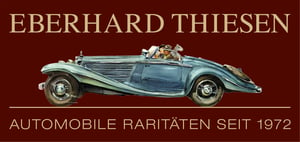1922 Hudson Super Six
Special Race Car-
Year of manufacture1922
-
Car typeConvertible / Roadster
-
Competition carYes
-
DriveLHD
-
ConditionRestored
-
Interior colourBrown
-
Interior typeLeather
-
Number of seats2
-
Location

-
Exterior colourBlack
-
GearboxManual
-
Performance76 PS / 56 kW / 75 BHP
-
Drivetrain2wd
-
Fuel typePetrol
Description
• Früher im Besitz des Rennfahrers Antonio Trabucco in Argentinien, er verkaufte den Rennwagen 1939 an Herrn Jaima Juan in Buenos Aires
• im Jahr 2014 von einem Österreicher in Argentinien entdeckt und gekauft, von dort in die EU importiert und in Deutschland bei einem Fachbetrieb (partiell) instandgesetzt
• restauriert/instandgesetzt und funktionsfähig
• 6-Zylinder-Reihenmotor, Hubraum 4.696 ccm, ca. 76 PS, 4-Gang-Getriebe
• sehr eindrucksvolles und authentisches Erscheinungsbild
• Farbgebung in schwarz mit hellbraunen Ledersitzen
• nur 19 Exemplare gebaut
• Dokumentiert mit historischen Unterlagen, Fotos und Korrespondenz (digital vorhanden)
• großartige frühe Renngeschichte in Südamerika mit dem Rennfahrer Antonio Trabucco, u.a.:
06. - 09.03.1924 = Gran Premio Nacional Argentina (1.496 km)
13.04.1924 = Premio Otono (400 km) 5. Platz
12.10.1924 = II Circuito Audax Córdoba (505 km)
21. - 24.02.1925 = Gran Premio Nacional Argentina (1.540 km)
Die Hudson Motor Car Company wurde im Jahr 1909 in Detroit gegründet und benannt nach Joseph Lowthian Hudson, der das Startkapital für die Firmengründung aufbrachte. Die Marke erwarb sich schnell den Ruf eines innovativen Automobilherstellers. Folgende heute selbstverständliche Ausstattungsmerkmale erschienen zum ersten Mal in Hudson-Fahrzeugen: Anlasser, Warnleuchten für Öldruck und Lichtmaschine sowie ausgewuchtete Kurbelwelle. Ein weiteres Merkmal war das "Step-Down" Chassis, bei dem der Fahrzeugrahmen tiefer zwischen den Achsen lag, was für Stabilität und ein besseres Fahrverhalten sorgte. Bis zum Ende der 1930er Jahre hatte sich Hudson mit bis zu 300.000 Fahrzeugen jährlich auf den dritten Platz nach Stückzahlen der amerikanischen Autohersteller vorgearbeitet. Im Jahr 1929 stellten nur Ford und Chevrolet mehr Autos her.
Der Super Six war ein Sechszylinder-Modell, das von 1917 bis 1928 gefertigt wurden. Später lebte die Modellbezeichnung mehrmals wieder auf. Der Antrieb war ein Reihen-Sechszylindermotor mit 4,7 Liter Hubraum und einer Leistung von 76 PS bei 2.450/min. Über eine korkbelegte Ölbad-Kupplung wurde die Motorkraft an ein Dreiganggetriebe und dann an die Hinterräder weitergeleitet. Das Fahrgestell hatte einen Radstand von 3.188 mm und konnte mit verschiedenen, meist viertürigen Aufbauten versehen werden. Zudem gab es ein zweitüriges Cabriolet. Ab 1922 waren neben den Werkskarosserien auch Limousinen von Biddle & Smart erhältlich. Mit dem Super Six wurde Hudson seinerzeit zum größten Hersteller von Sechszylinder-Motoren und Modellen.
----------
• Formerly owned by the racing driver Antonio Trabucco in Argentina, he sold the racing car in 1939 to Mr. Jaima Juan in Buenos Aires
• Discovered and bought by an Austrian in Argentina in 2014, imported from there into the EU and (partially) repaired in Germany by a specialist company
• Restored/overhauled to well condition and functional
• Six-cylinder in-line engine, displacement 4,696 cc, approx. 76 hp, 4-speed-gearbox
• very impressive and authentic appearance
• colour scheme in black with light brown leather seats
• only 19 examples built
• documented with historical records, photos and correspondence (digitally available)
• great early racing history in South America with racing driver Antonio Trabucco, inter alia:
06. - 09.03.1924 = Gran Premio Nacional Argentina (1,496 km)
13.04.1924 = Premio Otono (400 km) 5th place
12.10.1924 = II Circuito Audax Córdoba (505 km )
21. - 24.02.1925 = Gran Premio Nacional Argentina (1,540 km )
The Hudson Motor Car Company was founded in Detroit in 1909 and named after Joseph Lowthian Hudson, who provided the start-up capital for the company. The brand quickly gained a reputation as an innovative car manufacturer. The following features, which are taken for granted today, appeared for the first time in Hudson vehicles: starter motor, warning lights for oil pressure and alternator and balanced crankshaft. Another feature was the "step-down" chassis, in which the vehicle frame was positioned lower between the axles, which ensured stability and better handling. By the end of the 1930s, Hudson had worked its way up to third place among American car manufacturers in terms of unit sales with up to 300,000 vehicles per year. In 1929, only Ford and Chevrolet produced more cars.
The Super Six was a six-cylinder model that was produced from 1917 to 1928. The model designation was later revived several times. It was powered by an in-line six-cylinder engine with a displacement of 4.7 litres and an output of 76 hp at 2,450 rpm. The engine power was transmitted to a three-speed gearbox and then to the rear wheels via a cork-covered oil-bath clutch. The chassis had a wheelbase of 3,188 mm and could be fitted with various, mostly four-door bodies. There was also a two-door cabriolet. From 1922, saloons from Biddle & Smart were also available in addition to the factory bodies. With the Super Six, Hudson became the largest manufacturer of six-cylinder engines and models at the time.



















